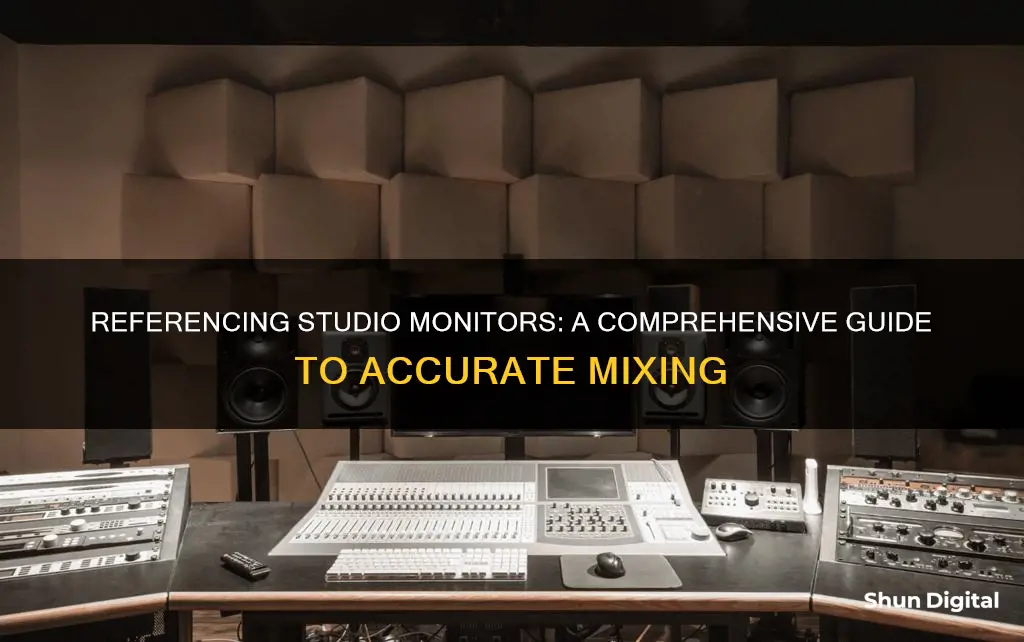
Studio monitors are an essential component of any recording setup, and it's not uncommon to see multiple sets of monitors in use at the same time. But why is this? In this article, we'll be exploring the reasons behind this practice and providing a comprehensive guide to studio monitors, including the different types available and how to choose the right ones for your needs. We'll also be discussing the pros and cons of using multiple monitors and offering tips for optimal placement to ensure the best listening experience. By the end, you should have a clear understanding of how to reference recordings of three different studio monitors.
| Characteristics | Values |
|---|---|
| Number of monitors | 3 |
| Purpose | To reference recordings |
| Monitor type | Studio monitors |
| Monitor design | 2-way or 3-way |
| Active or passive | Active or passive |
| Amplifier configurations | Single-amp, bi-amp, or tri-amp |
| Speaker size | Varies, e.g. 5-inch |
| Wattage | 50-75 watts per channel for beginners |
| Cost | $200-$400 for beginners, $400-$1,000 for intermediate, upwards of $1,000 for professionals |
| Placement | Near-field or far-field |
| Ported or unported | Ported or unported |
What You'll Learn

Near-field vs far-field monitors
Near-field monitors are typically used for detailed work on a mix or master. They have smaller drivers, usually between 5 and 8 inches, and are placed close to the listener—generally around 2 to 4 feet away. This proximity means that more direct sound will reach the listener's ears, as opposed to reflected sound bouncing around the room. Near-field monitors are ideal for critical mixing, mastering, and editing purposes, as their smaller drivers produce a slightly narrower frequency response with a relatively flat sound, ultimately offering a better representation of how a consumer will hear the mix.
Far-field monitors, on the other hand, are those large installations you often see in major studios. They have bigger drivers, sometimes more than one, and are mounted on or inside the wall, usually near the corners of the room, and are placed further from the listening position—up to 10 feet or more. The larger drivers produce more low-end frequencies, and the longer wavelengths have more time to develop due to the increased distance from the listening position. Room acoustics play a significant role in the sound of far-field monitors, as the increased distance results in more reflected sound. Far-field monitors are excellent for checking the overall balance of a mix and are also great for impressing clients and engaging a packed room.
The majority of people work with near-field monitors, while far-field monitors are usually reserved for the biggest rooms and professional studios. Near-field monitors are more practical, logical, and financially sensible for most studios, especially home studios, as far-field monitors require a lot of space and depend heavily on the acoustics of the room, often necessitating additional investment in room treatment.
Understanding Studio Monitors: Input, Output, and Their Dual Role
You may want to see also

Active vs passive monitors
When it comes to studio monitors, there are two types to choose from: active and passive. Each has its own advantages and considerations, catering to different needs and preferences.
Active Monitors
Active studio monitors are known for their simplicity and ease of use. They have built-in amplifiers, eliminating the need for external amplifiers and additional equipment. This makes them a convenient plug-and-play option, saving you time and effort in setup. The built-in amplifiers are designed specifically for the monitors, resulting in better overall sound quality. They also offer benefits such as optimised power amps for each driver, optimised driver-protection circuitry, and short connections between amps and drivers. Additionally, active monitors provide more precise control over the frequency response, leading to more accurate sound reproduction. The bi-amp and tri-amp configurations in active monitors contribute to a flatter frequency response and greater definition.
Passive Monitors
Passive monitors, on the other hand, offer flexibility. They require external amplifiers, allowing you to choose and pair the perfect amplifier to your monitors. This separates the two components of your monitoring system, enabling you to upgrade them independently. This flexibility makes passive monitors a more cost-effective option, as you can gradually progress to better-quality gear. However, it is important to ensure that the amplifier matches the power rating and impedance of your passive monitors for optimal performance. Additionally, passive monitors give you the freedom to choose an amplifier that suits your monitors, which can lead to a better amplifier in some cases.
Making the Choice
The decision between active and passive monitors depends on your specific needs and preferences. If you prioritise convenience, accuracy, and a plug-and-play solution, active monitors are the way to go. On the other hand, if flexibility and the ability to customise your setup are important to you, passive monitors might be a better choice. It is worth noting that while passive monitors offer advantages, countless professional studios worldwide rely on active monitoring systems with excellent results.
Monitoring Web Usage: Strategies for Tracking Online Activity
You may want to see also

2-way vs 3-way design
When it comes to studio monitors, there are two main designs to choose from: 2-way and 3-way. Both have their pros and cons, and the right choice depends on your specific needs, preferences, and budget.
2-Way Monitors
2-way monitors are the most common type of studio monitors and feature two drivers: a woofer for low frequencies and a tweeter for high frequencies. They are typically smaller, more portable, and more affordable than 3-way monitors. 2-way monitors are ideal for casual listeners, home enthusiasts, and amateur musicians, as they offer a good balance of quality and affordability. They are also suitable for basic music production tasks, such as creating rough mixes or listening to music. Additionally, 2-way monitors are often preferred for their simplicity and ease of use.
However, one of the drawbacks of 2-way monitors is that the crossover frequency, typically between 1.5 to 2.5 kHz, can cause issues with sound reproduction in the midrange. This is because the woofer and tweeter are trying to reproduce the same notes from different positions, which can lead to a mix-up and less clear or precise sound. Additionally, the tweeters in 2-way monitors are usually less efficient at reproducing upper midrange frequencies.
3-Way Monitors
3-way monitors, on the other hand, feature an additional midrange driver dedicated solely to midrange frequencies. This results in a more balanced sound and improved clarity and separation between the bass, midrange, and treble frequencies. 3-way monitors are often preferred by audiophiles and audio professionals who require the highest level of accuracy and sound fidelity. The inclusion of a midrange driver also reduces the workload on the woofer and tweeter, allowing them to focus solely on the bass and treble ranges, respectively.
However, 3-way monitors are generally more expensive, larger, and more complex than 2-way monitors. They require careful tuning and calibration to ensure that the multiple drivers work together evenly and contribute precise amounts of output. Additionally, the increased number of drivers and crossovers in 3-way monitors can introduce time alignment and phase issues.
In conclusion, the choice between 2-way and 3-way monitors depends on your specific needs and budget. If you are looking for a simple, affordable, and portable option, a 2-way monitor may be the best choice. On the other hand, if you require the highest level of accuracy and sound fidelity, a 3-way monitor is the way to go. Ultimately, it is important to consider your specific requirements and budget constraints when making a decision.
ASUS Monitor Aspect Control: Adjusting Display for Optimal Viewing
You may want to see also

Amplifier configurations
The single-amp configuration is the simplest of the three, typically found in active studio monitors. In this setup, a single amplifier powers both the left and right speakers, although it is less common in studio monitors and more often seen in computer speakers. This configuration is straightforward to operate and is suitable for basic studio requirements.
For more advanced applications, the bi-amp configuration offers greater control over the frequency response. In this setup, each speaker features two amplifier modules, providing dedicated amplification for each driver in a 2-way design. This results in more precise sound reproduction, making it a preferred choice for professional studios where accuracy and detail are paramount. While some 3-way speakers utilise a similar approach, it is not the ideal method for amplifying such systems.
The tri-amp configuration is the most advanced and complex of the three, typically employed in high-end professional studios. In this setup, each driver in a 3-way speaker (woofer, midrange, and tweeter) has its own dedicated amplifier, allowing for ultimate control over the frequency response. This configuration provides the highest level of precision, ensuring the most accurate sound reproduction for critical listening and mixing environments.
When selecting an amplifier configuration, it is essential to consider the specific needs of your studio setup. The single-amp configuration offers simplicity and ease of use, while the bi-amp and tri-amp configurations provide enhanced accuracy and control over the sound output. The choice between these configurations depends on factors such as the size of the studio, the type of work being undertaken, and the level of precision required.
Choosing the Right Cable for Your Monitor Setup
You may want to see also

Monitor placement
- Room Placement: Avoid placing your setup in the centre of the room, as sound tends to be least reliable there. Instead, position your setup in the front area of the room, dividing it into three areas of equal sizes. Your listening position should be centred relative to the wall it faces, and your monitors should be equidistant from the walls to their side and back, with different distances between those two. If your room is rectangular, prioritise one of the long walls as the one your listening position will be centred against to minimise potential reflections from the sidewalls.
- Distance from Walls: Maintain a minimum distance of 20-30 cm (8-12 inches) between the monitors and walls to reduce sound wave reflections. The maximum distance should be between 60 and 90 cm. Ensure the distances between the monitors and the side and back walls are different to avoid creating corners in your listening position. A recommended setup is placing the monitors 40-60 cm away from the back walls and 60-90 cm from the sidewalls.
- Creating the Sweet Spot: Position the listener and monitors at the three points of an equilateral triangle, with the monitors angled towards the listening position at around 30 degrees. This alignment ensures the monitors are directed at the listener's ears. For accurate high-end frequency perception, it is recommended to have the centre of the tweeters at ear level. If this is not feasible, consider using angling stands to raise the monitors and angle them appropriately.
- Separating Monitors from the Setup: Avoid placing monitors directly on hard surfaces, such as a console or desktop, to prevent unwanted reflections and vibrations. Instead, use monitor stands or decouplers/isolation pads to separate the monitors from the rest of the setup and adjust their distance and orientation more easily.
- Adding a Subwoofer: Before adding a subwoofer, ensure your monitor system is correctly positioned and calibrated for your space. Subwoofers can trigger room acoustics more than monitors, especially in untreated rooms. Place the subwoofer off-centre along the front wall, maintaining a distance from reflective surfaces. Test different positions using audio with low frequencies to find the optimal spot for your room. Aim for a flat response rather than exaggerated frequencies to ensure accurate mixes.
- Adjusting with DSP: Consider using monitors with DSP-enabled tools to adjust their settings according to your room's limitations. These tools can include desktop and shelving filters, bass extension, and linear phase configurations.
- Head Positioning: Centre your chair between the sidewalls to maintain a symmetrical stereo image. Ensure your head is not at the midpoint between the ceiling and floor. Position your chair/desk so it is not halfway between the front and back walls. Compare the distances on all three dimensions to ensure they are neither the same nor exact multiples of each other.
- Acoustic Treatment: Add bass traps behind the monitors to minimise reflected bass frequencies. Place acoustic panels or absorption materials at initial reflection points: two above your head, one on the left wall, and one on the right wall. Add diffusion to the rear wall to scatter sound energy and prevent standing waves.
Monitoring CPU Usage: JMeter's Performance Insights
You may want to see also
Frequently asked questions
Multiple sets of studio monitors can help you to understand how your mix will translate across different playback systems. For example, you might use three-way monitors, but most people listen to music on headphones or two-way speakers. A second set of two-way speakers can help you understand how your mix will sound to the majority of listeners.
A single set of studio monitors can be sufficient if you know them well. It's important to pick a set of monitors that works for you and that you enjoy listening to. You can learn how your favourite music and your past projects sound on them, and use that knowledge to inform your mixing decisions.
Three-way monitors have a dedicated loudspeaker for mid-range frequencies. This can offer greater clarity and precision for vocal and instrumental tracks.
Two-way monitors tend to be more cost-effective and are widely appreciated for their balance of quality and affordability. They are a good option for beginners and semi-professionals.
Active monitors have built-in amplifiers, so they are simpler to use and don't require any additional equipment. They are also designed so that the built-in amplifiers match the monitors well.







